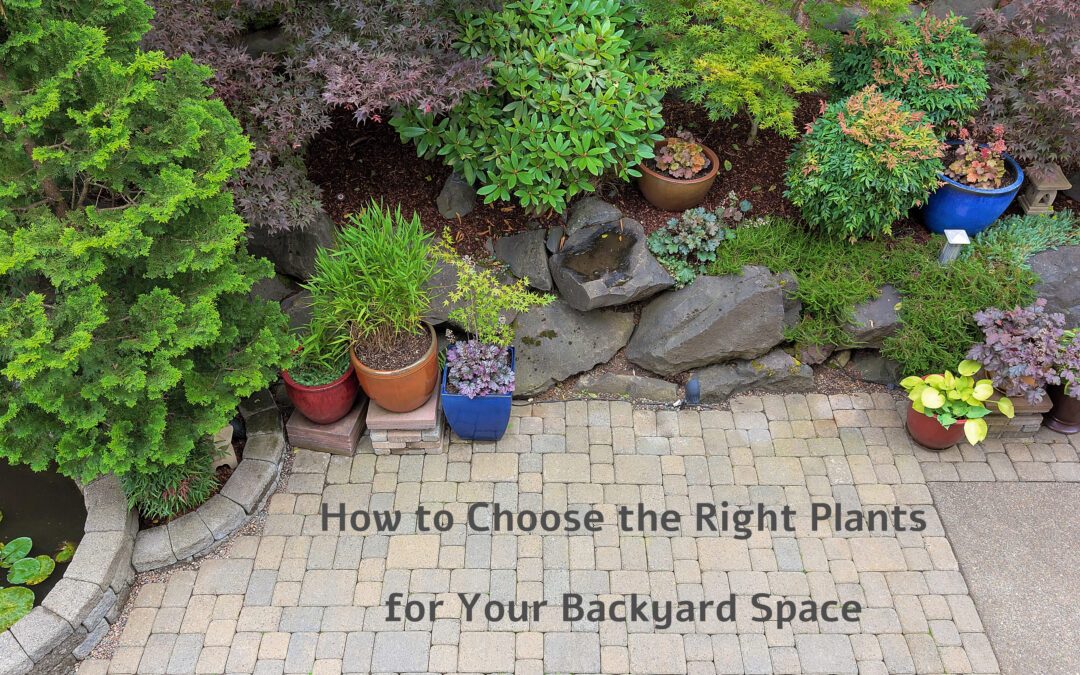==================
A Caveat and Affiliates
First off, a little caveat: within my articles you will find affiliate links, meaning if you buy them, I get a small commission. Your cost is not affected. In addition, I am an Amazon Associate and I earn from qualifying purchases on Amazon.
And yes, if I say that I recommend a product here, it means I truly believe it is a good product. I refuse to recommend any product that I have not researched and believe to be a good value.
Even better, I provide you with a very clear picture of the product, it’s use, and the probable value.
Earning your trust is important to me. I run this website myself and the commissions and donations help support the site.
Sound reasonable and fair enough? Let’s continue to the article.
==================
How to Choose the Right Plants for Your Backyard Space
Your backyard is a great place for the plants you love to grow, blossom, and multiply. It’s where your horticultural creativity comes alive, an expression of yourself. Not only do they make your backyard great to look at. Your passion and creativity in gardening get fulfilled. So, choose the right plants for your backyard well. If you need some help on how to choose the best plants for your yard, then read on.
When choosing the right plants for your backyard space, there are several factors to consider. Those include sunlight, water supply, type of soil, and more.
Factors to Consider When Choosing the Right Plants for Your Backyard
Here are some things to consider:
1) Sunlight

Flowering plant basking under the sunlight
The first step in choosing backyard plants is to get a pretty good idea of how much sunlight your yard gets throughout the day. Plants need at least six hours of sunlight a day to survive and thrive. Some plants need more than six hours of direct sunlight per day, while other plants may only require three or four hours of sun each day or even less. It’s also important to know how much shade there is in different areas of your yard before you choose which backyard plant you want to grow. This will help ensure that something doesn’t die once you transplant it into your garden space.
Once you more or less determine the amount of sunlight your yard gets, narrow down the list of potential plants to grow. For instance, if you live in an area that gets six hours of sunlight on average per day, then choose plants that need at least five or six hours of sunlight to thrive.
2) Soil Quality
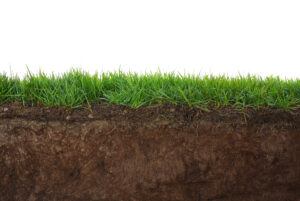
Soil quality gleaned from the underground perspective of grass and soil
Backyard soil quality will affect how well your backyard plants grow. If the soil is too dry it won’t allow for plant roots to grow strong and deep enough to survive, causing them to die off. Sunny locations tend to have very dry soil so adding mulch around the bases of your plants can help keep moisture levels up. Areas with more shade attract mold and mildew which makes the soil wetter. A garden area with high humidity may breed fungi, insects, and other pests that would make the soil wetter.
3) Water Supply
Your backyard space is not the only area you need to think about when planning what type of plant you want in your yard. You also must consider water supply options and how much time they will take up. However, there are all sorts of amazing things out there that require little water if any at all. Succulents are best if you’re looking for something simple with minimal work.
Water is one of the most important factors in plant growth and development. Some plants need more water than others, while some plants die off when they get too much rain or too little rain for an extended time. It’s not always easy to determine how much water specific plants need. Each species has different needs, like soil types and sunlight quantities.
Some good resources for finding information on backyard plants are garden catalogs. It offers lists of plant options by region or will have photos. They have descriptions of all sorts of gorgeous flowers, bushes, vines, and trees with details about what type of climate they prefer.
Another great resource is your local nursery to get the right plants for your backyard. They may offer online printable info sheets with details about the types of plants they have for sale. Or, you can ask an experienced staff member what type of plants are best for your local area.
4) Pests-resistant Plants
Next, consider whether or not there is any history of pest infestation in your backyard. If so, you may want to look into plant species that have a natural resistance to bug and insect attacks. Also, keep in mind that certain pests favor certain temperatures. So, they only invade the yard during specific times of the year. For example, mosquitoes will appear more frequently throughout the summer months rather than in winter. Find out what kinds of insects are present in your area that may pose problems.
5) Planting Season
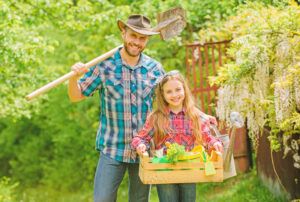
Dad and daughter planting
Different backyard plants have different growing seasons. Knowing what season your location falls into will help you choose the best types of plants for your space. This will ensure they grow well and look their best year-round.
For instance, some plants need a type of soil that is moist all year long. Meanwhile, others require a lot of water during certain months but not so much in other months during specific times.
Also, know that many regions have one or two months when it rarely rains, making those weeks dry as well. Too little water throughout the year from lack of rain can cause backyard plants to die off. Moreover, too much rainfall can lead to mold and fungus growth which may result in killing off healthy outdoor grasses.
6) Container Planting
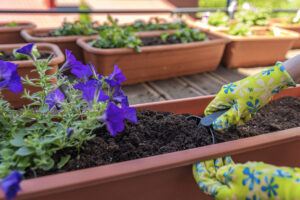
Plant flowers in a pot of soil in a container
If you’re on a tight budget, you may consider container planting. Many low-maintenance types of plants grow well in containers without needing any soil at all! You can have fun with this method by getting creative with the types of planters you use and how best to display them. You could even make it a DIY project and create one yourself. Such as driftwood planter boxes or old wine barrels repurposed as planters. Not only will this be less costly but should allow for more flexibility in design and creativity.
7) Perennials and Annuals

A garden border is a collection of perennial herbaceous plants
Finally, when choosing the types of plants you want in your backyard, consider whether or not you plan to do yearly plantings. You can choose annuals and perennials for this task. Annuals will only grow and survive in your yard for one year and then they die off in wintertime when cold weather hits.
Perennials, on the other hand, grow back every year with minimal care needed throughout the seasons. This makes it easy to just go into your yard each month or two. Or even less frequently when less watering is required. Also, remove fallen leaves around the perennial plants. You can do so without having to move them at all because they remain in their original spot each year once planted.
As always, before planting new outdoor plants make sure to contact local utilities and service providers. This includes weather, water, and cable for information about what types of plants grow best in your area.
right plants for your backyard
How to Find the Ideal Plants for Your Backyard
If you are looking for plants to add to your garden, first determine how much time and money you are willing to spend on your gardening project. Then diversify based on the time you have available, the seasons you live through, and the types of plants that fall into your preferred price range.
1) Do Some Basic Research
First, research what types of plants grow well in your region. There are many online resources available with lists of water-resistant plants.
Another great resource is your local nursery.
2) Determine the Types of Plants You Want to Buy
Next, think about what you want from your garden and match those up with types of plants that can grow well in your geographic location. For example, if you only have a few hours every week during the spring and summertime to tend your garden, focus on smaller types of ornamental flowers and ground covers. Choose ones that require little maintenance over a long period of time. This is better than larger bushes that may need constant upkeep throughout several seasons.
You’ll also want to consider having perennials that grow back each year. Choose ones that do not need as much attention as annuals do. If you live in an area where there is a dry season for at least one month out of the year, you’ll want to choose drought-resistant plants.
3) Utilize Local Resources
Consult your local garden center or nursery for affordable types of annuals and perennials. These are often on clearance after each spring season or during wintertime sales for people who didn’t plant their new outdoor flowers before summer arrived. You may also be able to get a discount by purchasing in bulk!
Also, ask friends and family members if they have any extra plants that have survived the harsh winter. So, you can save money and enjoy more variety when you go to plant your new backyard garden in early spring.
4) Container Planting
If you’re looking for low-maintenance options, container planting is a great way to grow ornamental flowers and small bushes. Container plants can be moved inside for the wintertime months when they’re not safe outside. This makes gardening completely effortless all year long! You can also use containers as decoration or as focal points in your yard!
5) Planting Near Utilities
Be aware of where utilities run in your backyards. Such include gas lines and electricity cables. This could potentially damage growing plants over time. Also, make sure to avoid planting near septic tanks and other things. They may emit harmful chemicals into the ground like pools and ponds. It’s better to plant along fences and borders where you will not need access to these areas frequently. That way, it will be easier to tend your garden without getting in the way of any utilities.
6) Allocate Time to Your Garden
It’s important to take into account how much time you should have for your garden when planning your planting session. It is crucial to choose the types of plants that fit into the amount of time you’ll be able to care for them. You do not want to spend money on an ornamental flower or plant only for it to die after a few months because you did not have enough time each week to tend it.
If you’re looking for easy ways to add liveliness and color throughout your backyard space, consider planting small ornamental flowers. Such can be pansies, snapdragons, poppies, petunias, and lavender. You can plant these in mid-spring and can grow well during the summertime. Also, if you don’t have pets or children, consider adding some grass to your yard. This is a great way to provide more outdoor play space for kids who won’t be able to roam around on an artificial lawn.
7) When do I plant?
Spring is often considered the best time of year for people to plant their gardens with flowers and small ornamental bushes. This season usually comes after winter when most plants die due to cold weather conditions. Because of that, it’s necessary to wait until spring arrives before buying new types of plants. It will add color and appeal throughout any backyard space.
However, there are certain types you can plant in autumn and wintertime. These include trees and shrubs, depending on the species you choose. This is because they tend to grow more slowly during cooler months. Remember that this season comes after summertime when plants might need a rest from the hot weather conditions
Planting your own garden can be easy and fun! Follow these tips before stepping outside to choose the right plants for your backyard space.
Steps on How to Select Plants for Landscaping
Landscaping is an excellent way to remarkably improve any backyard space. There are many varieties of ornamental plants and shrubs that can you include to create a beautiful garden in your backyard. Whether you’re looking for low-maintenance options, want easy ways to add color throughout your yard, or interested in container planting, there are many great ideas about how to choose the right plants for landscaping.
1) Select Low-Maintenance Plants
Low-maintenance plants are best when it comes to designing an appealing landscape. This is because they won’t require constant watering or trimming for them to look their best in any outdoor living space. You have more time for yourself if you do not have too much work cleaning up after each session of planting.
Be aware that there are exceptions to every type of plant. For example, some types of ornamental flowers would require a lot of watering. So, before buying plants, it’s important to research each type of plant you want to include in your landscaping. That way, you won’t have a problem with dead plants that do not look as beautiful as they should after a few days or weeks.
2) Add More Color with Easy-to-Grow Flowers and Bushes
Adding small ornamental flowers and bushes is one of the best ways to add color to any yard space without too much work involved. You can choose from many different colors and species that will look great in both your front and backyard spaces. Make sure to check what types of flowers and bushes work best with the time you have to tend to them.
3) Add Shrubs and Other Bushes for a More Natural Look
Many people choose to add larger shrubs and bushes around their homes when it comes to landscaping. This is because they’re perfect for filling out empty spaces. Also, these natural-looking plants can help anchor or secure smaller varieties of colors throughout your backyard space. Make sure that there’s enough sunlight reaching each plant before adding any new varieties into your landscape design plan!
4) Use Container Gardening for Small Spaces and Indoor Living Areas
Container gardening is a great way to grow more ornamental flowers and small shrubs in small spaces or even inside a small apartment. This is a great way to enjoy the beauty of a garden without taking up too much time for maintenance. Make sure you’re choosing plants that can grow in small pots before purchasing them. Some flowers and bushes require a lot more soil space than others!
Contemporary Planting Ideas to Try
When it comes to gardening, there are a lot of ideas to try. However, choosing the right plants for your landscaping isn’t always easy. It takes a lot of time and research to discover what types will look best in each different space. That’s why adopting contemporary planting ideas in your yard is the best way to create a well-thought-out, manageable, and sustainable garden that’s just right for you.
A) Try Containers
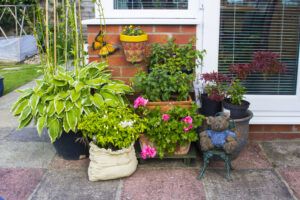
Different kinds pf plants in different containers
If you have limited outdoor living spaces or want something that’s low-maintenance, container planting is a great choice. There are many interesting containers with unique designs available online and in most local hardware stores. Make sure to choose something with an attractive design. So, it will be aesthetically pleasing for anyone who visits your home, regardless of whether they’re going into your backyard or not.
C) Experiment with Different Colors
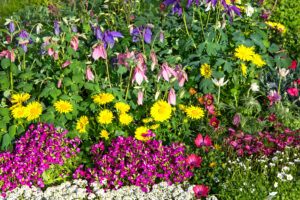
Plants with colorful blossoms
Another aspect of planting contemporary garden ideas is using different colors in your designs. Make sure that the color scheme works well not only by itself but also combined with other plants nearby. You want it to look great during each season of the year, not just spring or summer!
D) Use Small Bushes and Flowers

Top view of lilac flowers bush
If you’re running on too little time to take care of larger plants, adding small bushes and flowers around your yard can be a great idea! You can easily look up the best types of flowers and bushes to use by doing some research online. Make sure you’re using small varieties with limited needs so they won’t take too much time away from your daily routine.
E) Add Shrubs
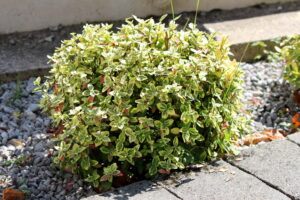
Wintercreeper or Euonymus fortunei evergreen shrub plant
Shrubs are another popular choice for anyone who wants to add more color to their backyard space. This way, you’ll love coming home after a long day of work knowing that your garden is still looking fresh! No matter what type of design you decide on for your yard, make sure it works well with any other areas in front or behind your house as well.
Different Types of Garden Styles
Garden styles are usually based on either the location or the inspiration behind them. There are many different styles to choose from, but most people would gravitate to just two or three garden styles. Selecting the right garden style means finding something that will suit your preferences. You may want it stylish, laid-back, minimalist, maximalist, traditional, contemporary, modern, and many more. And it’s perfectly okay when you infuse your ideas to make that style your own. These are just pointers, and one should pinpoint what he wants and have a definite plan on how to visualize it, up to its execution or realization.
A) Tropical Style
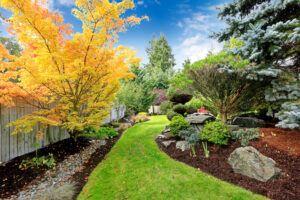
Tropical Garden Style
If you have a nice spot by your pool or outdoor kitchen where people can relax after a long day at work, tropical garden style might be perfect for you! This garden style is traditionally teeming with warm shades and tints of red, orange, and yellow. Vacation spots in Hawaii, Thailand, and other tropical locations bring about mental images that remind people about summer vacations and summertime living spaces. If you have a nice spot by your pool or outdoor kitchen where people can relax after a long day at work, this might be perfect for you.
B) English Garden Style
If you have limited backyard space and you want to add a few of your preferred colors quickly, an English garden style could be the one for you. This type usually involves bright flower beds in the center with paths that lead to areas like patios and water features. Don’t forget to include some benches or other seating for guests to rest and relax!
C) Mediterranean Style
For people who want something simple but elegant, a Mediterranean garden style might be their top option. The best part about it is the ease of maintenance since most plants are drought-resistant. If you live in a hot climate or have enough sunlight around your home, this can be a great choice for your outdoor living space.
D) Zen Style
If you have a smaller backyard space where it feels right to have larger plants around your home, Zen gardens are perfect for you. These are small areas that contain rocks or other hardscape materials, usually with something like bamboo or a fountain in the center. Make sure not to overcrowd and over-decorate these areas since they’re meant to be minimalist, calm, and relaxing! It wouldn’t be Zen style then.
E) Wildflower Style
These types of gardens are best for people who love flowers and would go for plants and flowers you don’t usually see in most residential gardens. So they are not hybrids or cultivars (cultivated varieties) but flowers growing in the wild. Wildflowers usually consist of taller grasses around the perimeter. It also has lots of colorful flowers growing throughout. This is also another great choice if you live in an area where droughts are common. Most wildflowers only need about an inch of water every week to stay alive!
F) Rock Garden Style
These types of gardens are usually smaller in size but tend to be the most popular with homeowners since they require little maintenance. These areas are often filled with ornamental plants that feature different colors and textures. It can come along with rocks or other hardscape materials that can change how someone is feeling when they look at the garden! Make sure you only use small varieties if you want these types of gardens because larger ones can take up too much space.
Obviously, this style features rocks and other hardscape materials, such as statuaries, garden wall accents and decors, and appropriate night lighting. Hardscapes nicely offset the softscape or plants, the living entities that give life and beauty to the garden. Such enhancements and features can surely evoke positive feelings for anyone viewing such breathtaking rock gardens.
Should you have limited yard space, make sure you only use smaller varieties because larger ones can take up so much space.
G) Container Gardening
This type of garden style comes in many different forms. Here, the focus is on using large containers, or planters, placed in strategic areas in the yard. They may even be placed on the entry and side porches, or on the terrace. Practically any nook that needs some focal point or accent. Their hard-to-ignore advantages are their versatile placements in nooks and places they can be displayed and the types of planters to combine. Through the four seasons, they can be easily placed temporarily where they would not be affected or damaged.
Many people like this style because everyone gets some extra space around the house. It’s perfect for patios if you want to add some color without too much work. And you can take this approach to free up extra space around the house. Position some potted or container plants in areas where some accent colorful plants are needed to liven them up.
Among container gardening’s main advantages is they can be placed in different combinations of container plants, and they can be placed or displayed anywhere you please. And it’s more than okay, and even recommended, to have other plants directly planted or grown on the ground for variety and contrast.
H) Rockery Style
If you have a large yard where there’s plenty of space for plants and rocks, this garden style is hands down the best choice or one of the best. The rockery garden style usually consists of lots of little shrubs and flowers in small areas enhanced by rocks. These areas are usually part of larger gardens with more features. Such as fountains or ponds so they’re not overcrowded while still looking inviting. This is also considered the most tranquil garden style because it focuses more on nature than on man-made hardscapes or landscape features.
I) Nature Garden Style
This garden style calls for plants that are native or natural to specific areas. This means you have to do a lot of research before creating one yourself! You can use whatever types of plants you want as long as they’re native to your location. The best part is that these plants don’t need any upkeep. That’s because everything growing will be tough enough to survive on its own.
What are some hardy shrubs for landscaping?
Blueberry bushes are a great option for landscaping. They produce beautiful blue-purple flowers and red berries that look like small tart cherries! They’re also a good choice for those who live in colder climates.
What is container gardening?
Container gardening is a great way to grow more ornamental flowers and small shrubs in limited or small spaces or even inside an apartment space. This is a great way to enjoy the beauty of a garden without taking up too much time maintaining it. Make sure that you’re choosing plants that can grow in containers before purchasing them. And some flowers and bushes require more soil space than others.
Are there any low-maintenance plants?
Yes, low-maintenance plants are best when designing an area that requires little watering and upkeep. Some of the best plants to use are ornamental grasses, wildflowers, cacti, succulents, and other types of easy-care flowers. Also, determine which plants are drought-resistant and which are not.
What are some common mistakes when planting?
When choosing hardscape materials like rocks or wood for patios or walkways, avoid using darker colors that aren’t very inviting. On the other hand, avoid strong colors too that can be distracting. You should also avoid placing large objects in small areas since it will make them look cramped rather than inviting and not suffocating. The operative word is proportion. Also, remember to create an area where people can rest, linger, and still feel they are in a garden.
Is there anything else I need to know about landscaping?
If you don’t have much outdoor space left for landscaping and gardening, consider container gardening and rockeries. This will not only make that area stand out without taking up too much space. Also, your outdoor living spaces would be an exciting, pleasant, and restful place to enjoy many outdoor activities. That’s from daylight to early evening when various kinds of outdoor lighting lend a magical and wondrous ambiance you would enjoy.
Conclusion
The yard around your house is an important area that needs to be maximized in the way the family uses it. The backyard especially is the most private where a patio and a garden are enhanced with food plants and flowering decorative plants provide satisfaction in many ways. It’s an outdoor family living space where you get sunlight and the breeze, and enjoy the stars and the moon at night. And so, identifying the right plants for your backyard space ensures that you enjoy and benefit from the plant life thriving in your backyard.
